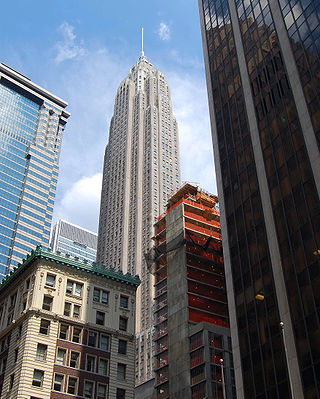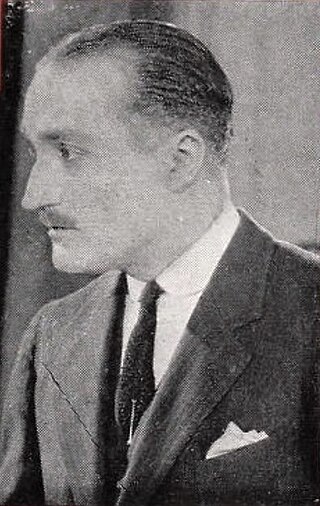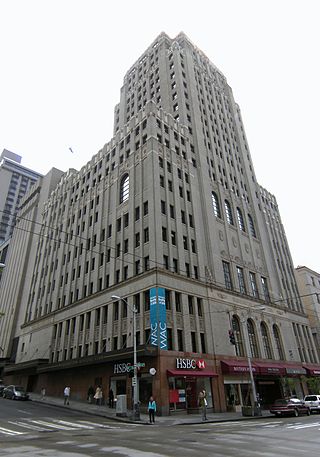
70 Pine Street is a 67-story, 952-foot (290 m) residential building in the Financial District of Lower Manhattan in New York City. Built from 1930 to 1932 by energy conglomerate Cities Service Company, the building was designed by the firm of Clinton & Russell, Holton & George in the Art Deco style. It was Lower Manhattan's tallest building and the world's third-tallest building upon its completion.

1 Wall Street is a mostly residential skyscraper in the Financial District of Lower Manhattan, New York City, on the eastern side of Broadway between Wall Street and Exchange Place. 1 Wall Street, designed in the Art Deco style, is 654 feet (199 m) tall and consists of two sections. The original 50-story building was designed by Ralph Thomas Walker of the firm Voorhees, Gmelin and Walker and constructed between 1929 and 1931, while a 36-story annex to the south was designed by successor firm Voorhees, Walker Smith Smith & Haines and built between 1963 and 1965.
Melville Corporation was a large retail holding company incorporated by Ward Melville in 1922 from Melville Shoe Company. Formerly based in Rye, New York, it became CVS Corporation in 1996 under a massive reorganization plan. The company traded on the New York Stock Exchange (NYSE) under the ticker MES, before changing its ticker to CVS.

Marriott Corporation was a hospitality company that operated from 1927 until 1993, founded by J. Willard Marriott and Frank J. Kimball as Hot Shoppes, Inc. In 1957, Marriott Corporation opened its first hotel in Arlington County, Virginia, United States as the Twin Bridges Motor Hotel.

Ernest Hilliard was an American actor. He appeared in more than 90 films between 1921 and 1947. He was born in New York City and died in Santa Monica, California, from a heart attack.

Tommy Paul was a world featherweight boxing champion from Buffalo, New York. He won the world featherweight championship in May 1932, defeating Johnny Pena in a boxing tournament in Detroit. He was inducted into the first class of Buffalo’s Ring No. 44 Boxing Hall of Fame and in 2003 to the Greater Buffalo Sports Hall of Fame. He retired from the ring in 1935.

James Addison Johnson was an American architect known for his design of various architectural landmarks in Buffalo, New York, and his use of decorative work that many consider a foreshadowing of art deco design.
The Segal Lock and Hardware Company of Manhattan, New York, was a leading manufacturer of hardware merchandise and razor blades in the 1920s and 1930s. Established in Connecticut and Manhattan, the firm relocated to Brooklyn, New York, in the mid-1920s. The Segal Safety Razor Corporation was a subsidiary of the Segal Lock and Hardware Company. The business was at first known as the Burglar-Proof Lock Company.
Consolidated Indemnity and Insurance Company was a Hartford, Connecticut-based firm which became insolvent during the Great Depression. The corporation is important because it employed executives who were formerly directors of significant business concerns of New York City, in the early 1930s and before. Consolidated Indemnity and Insurance Company was organized in October 1928 with a capital of $2,500,000 and a surplus of $7,300,000. Among its fifteen directors were Saul Singer, vice-president of the New York Bank of the United States and C. Stanley Mitchell, president of the Central Mercantile Trust Company. Its president was John F. Gilchrist, chairman of the Tate Transit Commission. Gilchrist was a close personal and boyhood friend of Alfred E. Smith.

Botany Mills was a Passaic, New Jersey, manufacturer of textiles, which was organized in 1887. It merged with Continental Textile Co., Ltd., in January 1927. Botany Mills continued to have a controlling interest in both Botany Worsted Mills and Garfield Worsted Mills. The company was a key target of the 1926 Passaic Textile Strike, which lasted almost a year. The business is significant for having survived the Great Depression while continuing to be a leader in its field in the decades afterward.
American Yvette Company was a Chicago, Illinois based business that manufactured cosmetics and operated beauty shops. It thrived in the late 1920s and 1930s. The company ran hairdressing and beauty shops in thirty-seven leading department stores in thirty-four cities in the United States, in February 1929. It maintained exclusive rights to manufacture and sell Evera permanent wave machines in the United States and foreign countries. The firm is significant for being innovative during the Great Depression, especially in maintaining efficiency of production.
Starrett Corporation, formerly known as Starrett Brothers, Inc. and Starrett Brothers and Eken, is a real estate development and construction firm known for having built the Empire State Building, Stuyvesant Town, Starrett City and Trump Tower in New York City.

The Rapids Theatre is an indoor concert venue and events center situated in downtown Niagara Falls, New York. It hosts a variety of shows and events, including music concerts, comedy acts, wedding receptions, and corporate meetings. Some performances recently held at the Rapids include Passion Pit, Stone Temple Pilots, Pauly Shore, Morrissey, City and Colour, Thirty Seconds to Mars, Snoop Dogg, The Band Perry, Dropkick Murphys, Chevelle, the Headstones, and Eric Church. The venue was also featured on an episode of SyFy's Ghost Hunters that aired on October 19, 2011. The episode was appropriately titled "Stage Fright".

The Washington Athletic Club, founded in 1930, is a private social and athletic club located in downtown Seattle. The 21-story WAC clubhouse opened in December 1930, and was designed in the Art Deco style by Seattle architect Sherwood D. Ford.

John Durrant Larkin was an American business magnate who pioneered the mail-order business model, developed the marketing strategy of offering premiums to customers, introduced revolutionary employment innovations, and commissioned Frank Lloyd Wright's first major public work, the Larkin Administration Building.

The American Stock Exchange Building, formerly known as the New York Curb Exchange Building and also known as 86 Trinity Place or 123 Greenwich Street, is the former headquarters of the American Stock Exchange. Designed in two sections by Starrett & van Vleck, it is located between Greenwich Street and Trinity Place in the Financial District of Lower Manhattan in New York City, with its main entrance at Trinity Place. The building represents a link to the historical practices of stock trading outside the strictures of the New York Stock Exchange (NYSE), which took place outdoors "on the curb" prior to the construction of the structure.
Beacon Oil Company was an American oil and gas corporation headquartered in Boston.
Wolfgang Hoffmann (1900–1969) was an Austrian-American architect and designer active in the American modernism movement between 1926 and 1942. His reputation was overshadowed by that of his father, the architect and designer Josef Hoffmann, and ex-wife, Josefine Pola Weinbach Hoffmann, better known as Pola Stout.
Houdaille Industries was a diversified manufacturing company which produced automotive products, industrial products, machine tools, construction materials and contracting. The company had its beginnings in Buffalo, New York, in 1919, where the Houde Engineering Corporation manufactured shock absorbers that had been invented and patented in France by Maurice Houdaille (1880-1953). The company continued to grow with the automobile industry, and through diversification, until 1987 when it was forced to liquidate most of its assets to satisfy obligations to investors from a 1979 leveraged buy out.










